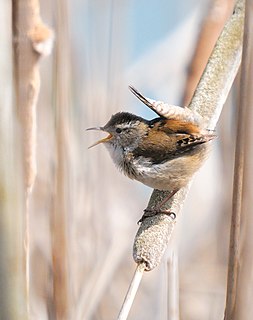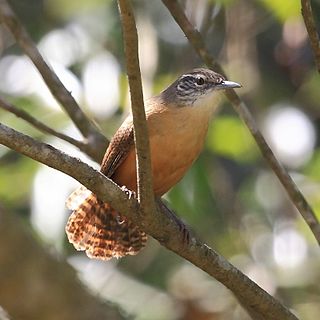
Sir Christopher Wren PRS FRS was an English anatomist, astronomer, geometer, and mathematician-physicist, as well as one of the most highly acclaimed English architects in history. He was accorded responsibility for rebuilding 52 churches in the City of London after the Great Fire in 1666, including what is regarded as his masterpiece, St Paul's Cathedral, on Ludgate Hill, completed in 1710.

Wrens are a family of mostly small, brown, passerine birds in the (mainly) New World family Troglodytidae. The family includes 88 species divided into 19 genera. Only the Eurasian wren occurs in the Old World, where, in Anglophone regions, it is commonly known simply as the "wren", as it is the originator of the name. The name wren has been applied to other, unrelated birds, particularly the New Zealand wrens (Acanthisittidae) and the Australian wrens (Maluridae).

The house wren is a very small songbird of the wren family, Troglodytidae. It occurs from Canada to southernmost South America, and is thus the most widely distributed bird in the Americas. It occurs in most suburban areas in its range and it is the single most common wren. Its taxonomy is highly complex and some subspecies groups are often considered separate species.
Wren Day, also known as Wren's Day, Day of the Wren, or Hunt the Wren Day, is celebrated on 26 December, St. Stephen's Day in a number of countries across Europe. The tradition consists of "hunting" a fake wren and putting it on top of a decorated pole. Then the crowds of mummers, or strawboys, celebrate the wren by dressing up in masks, straw suits, and colourful motley clothing. They form music bands and parade through towns and villages. These crowds are sometimes called wrenboys.

Matthew Wren was an influential English clergyman, bishop and scholar.
The grey wren is a species of bird in the family Troglodytidae. It is endemic to humid forests in the southwestern part of the Amazonas state in Brazil. This small, poorly known wren somewhat resembles a house wren, but its upperparts are grey.

The fawn-breasted wren is a species of bird in the family Troglodytidae, the wrens. It is found in Bolivia, Brazil, and Paraguay. Its natural habitats are subtropical or tropical dry forests, subtropical or tropical moist lowland forests, subtropical or tropical swamps, and heavily degraded former forest.
The stripe-throated wren is a species of bird in the family Troglodytidae.

The buff-breasted wren is a species of bird in the family Troglodytidae, the wrens. It is found in the Amazon Basin of northern Brazil and Amazonian Colombia, Ecuador, Peru and northern-border Bolivia; also the Guianan countries Guyana, Suriname, French Guiana. It occurs in non-Amazonian regions of Venezuela and Colombia and its range extends into eastern Panama.

The long-billed wren is a species of bird in the family Troglodytidae. It is endemic to Brazil. Its natural habitats are subtropical or tropical dry forest, subtropical or tropical moist lowland forest, subtropical or tropical dry shrubland, and heavily degraded former forest.

Cabanis's wren is a species of bird in the family Troglodytidae. It is found in Belize, Costa Rica, El Salvador, Guatemala, Honduras, Mexico, and Nicaragua. It was considered conspecific with the canebrake wren and the isthmian wren, together called the plain wren. It is considered as a distinct species because of different vocalizations and genetic divergence.

The bay wren is an attractive and highly vocal wren species, readily observed in forested areas, especially along watercourses, in the lowlands and foothills of parts of southern Central America and northwestern South America. Its distinctive vocalizations draw attention to this inquisitive species, which is nevertheless an expert skulker.

The riverside wren is a species of bird in the family Troglodytidae. It is found in Costa Rica and Panama. Its natural habitat is subtropical or tropical moist lowland forests.

The superciliated wren is a species of bird in the family Troglodytidae. It is found in Ecuador and Peru. Its natural habitats are subtropical or tropical dry forests, subtropical or tropical moist lowland forests, subtropical or tropical mangrove forests, and subtropical or tropical dry shrubland.

The stripe-breasted wren is a species of bird in the family Troglodytidae. It is found in Honduras, Nicaragua, Costa Rica, and Panama. Its natural habitats are subtropical or tropical moist lowland forests and heavily degraded former forest.

Cantorchilus is a genus of birds in the wren family. Established by Nigel I. Mann, F. Keith Barker, Jeff A. Graves, Kimberly A. Dingess-Mann and Peter J. B. Slater in 2006, it contains 10 species. All of the species assigned to it were previously included in the genus Thryothorus.

The canebrake wren is a species of bird in the family Troglodytidae. It is found from eastern Nicaragua to northwestern Panama. Its natural habitats are subtropical or tropical dry forests, subtropical or tropical moist lowland forests, and heavily degraded former forest. It was considered conspecific with Cabanis's wren and the isthmian wren, together called the plain wren. It is considered as a distinct species because of different vocalizations and genetic divergence.

The isthmian wren is a species of bird in the family Troglodytidae. It is found from southwestern Costa Rica to western Panama. Its natural habitats are subtropical or tropical dry forests, subtropical or tropical moist lowland forests, and heavily degraded former forest. It was considered conspecific with Cabanis's wren and the canebrake wren, together called the plain wren. It is considered as a distinct species because of different vocalizations and genetic divergence.













